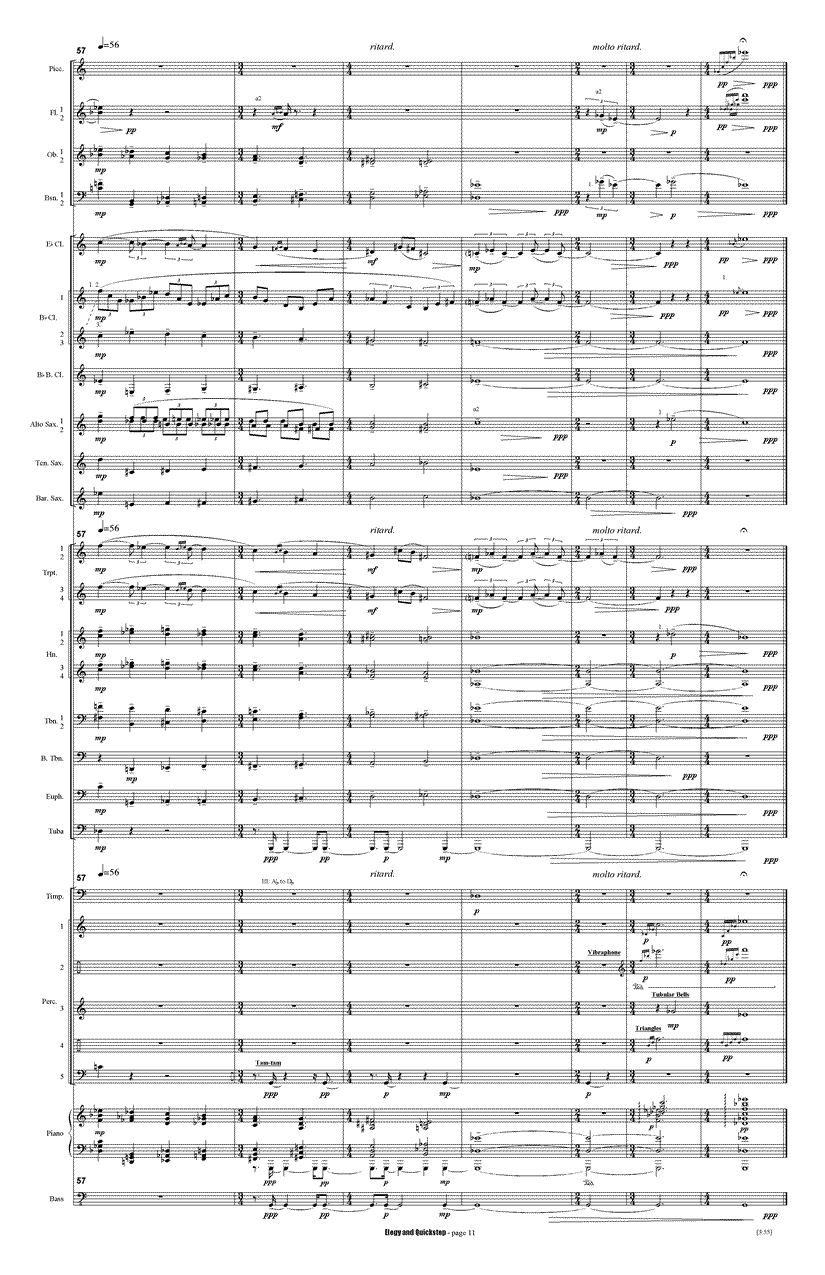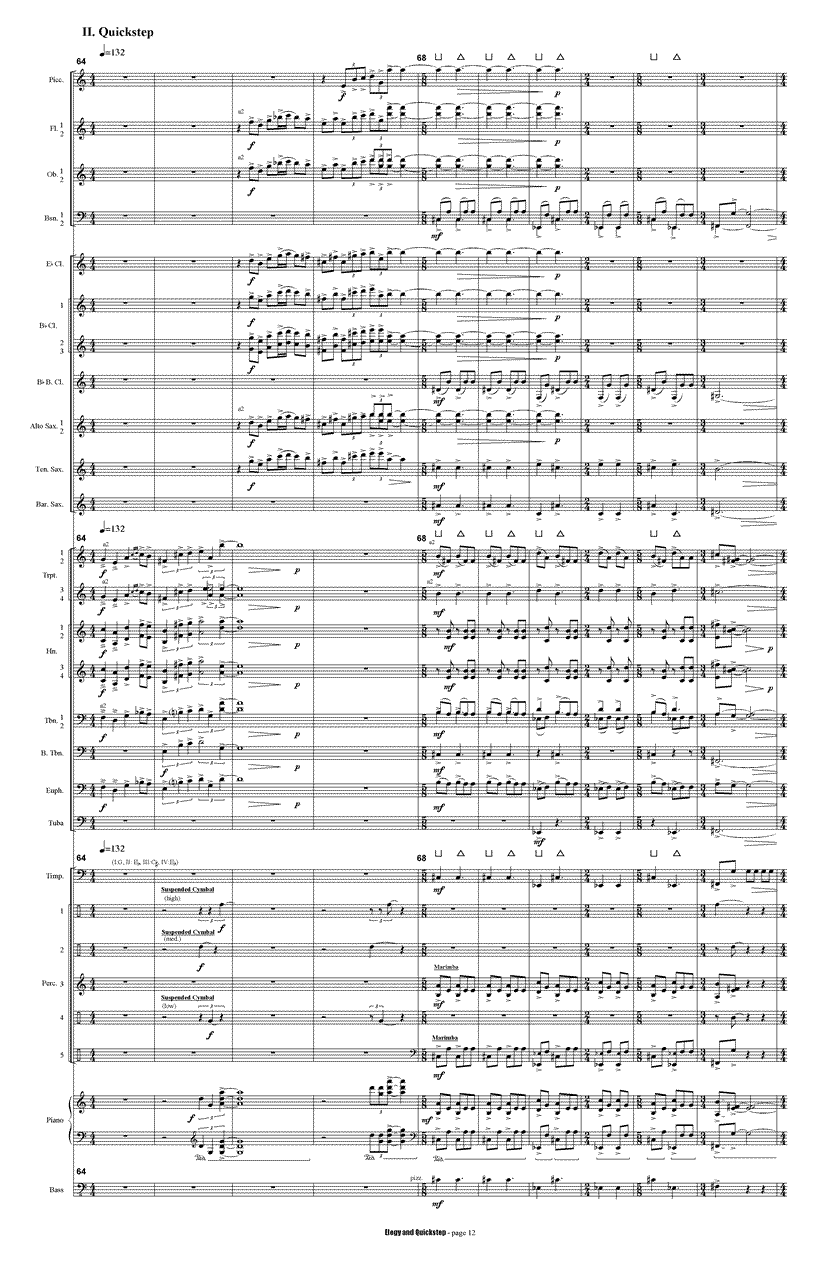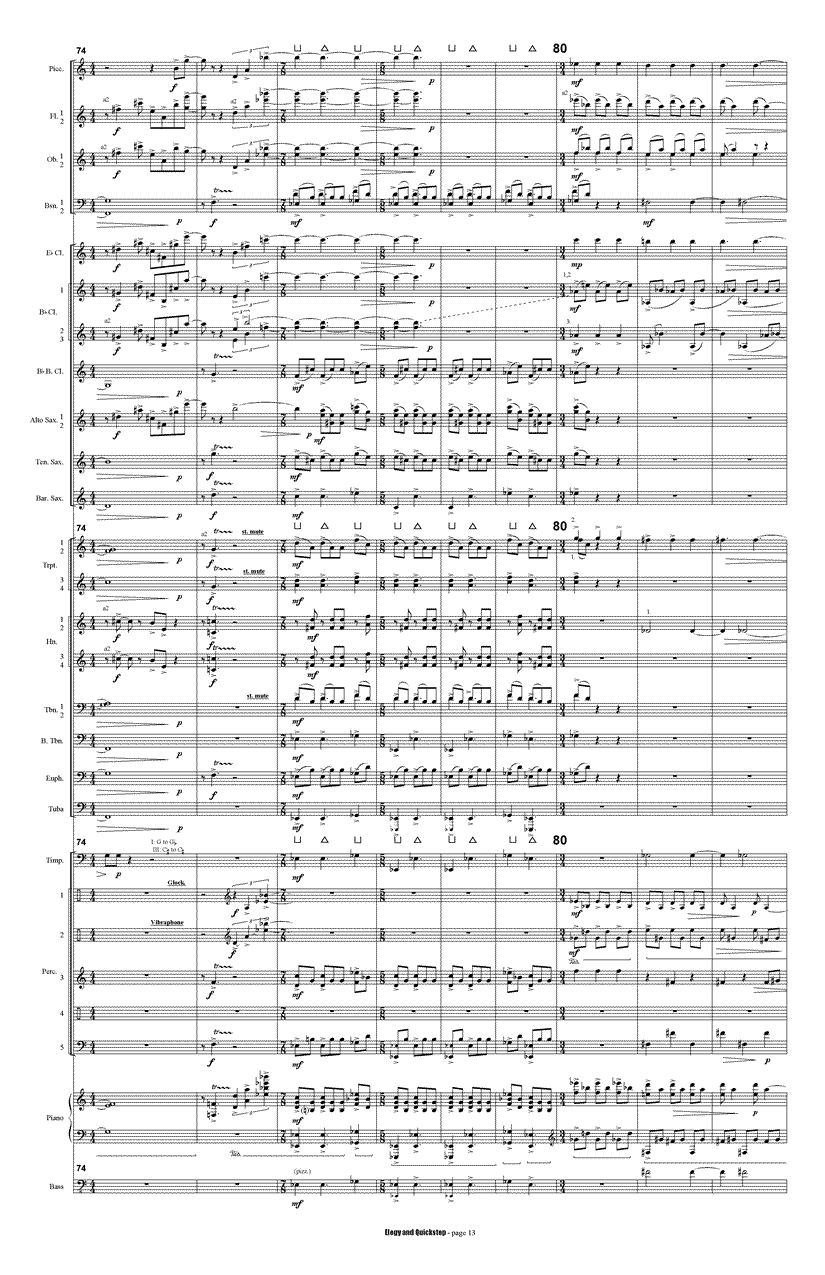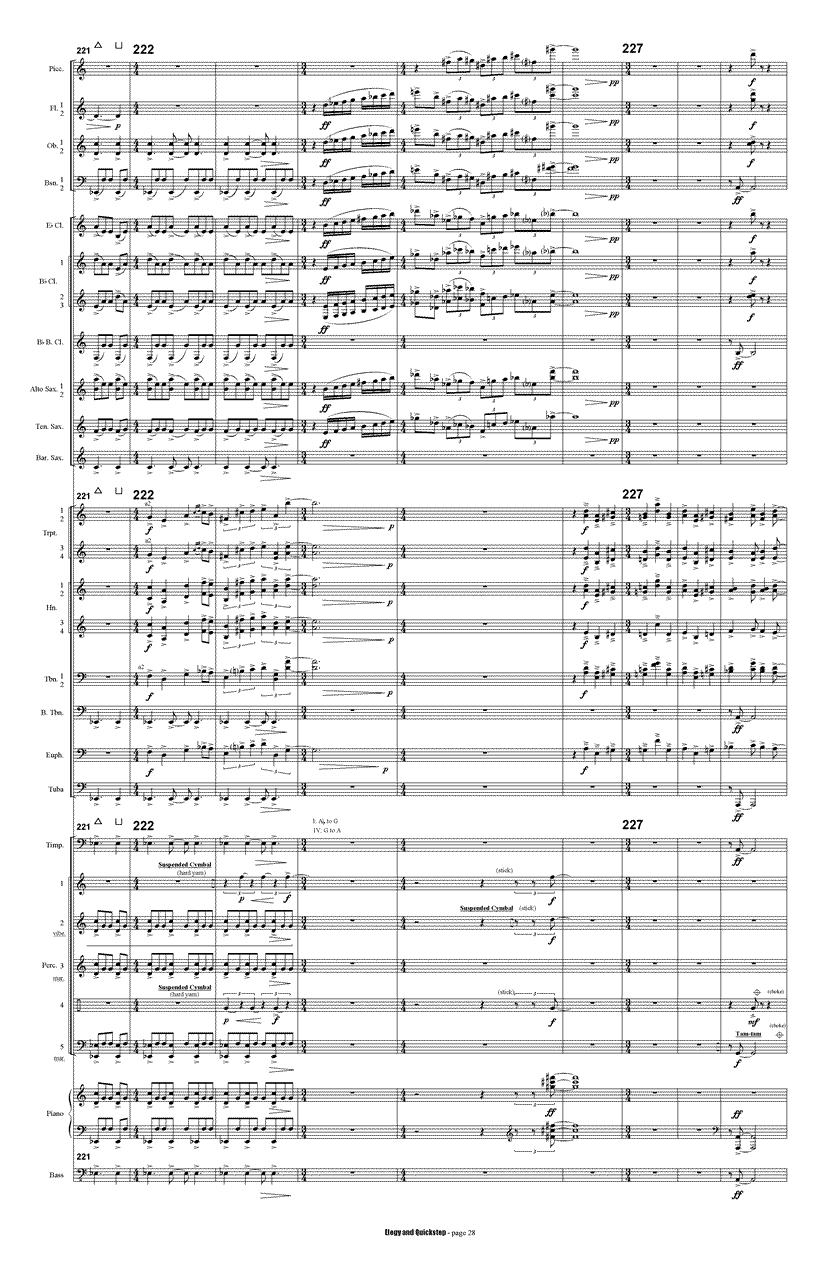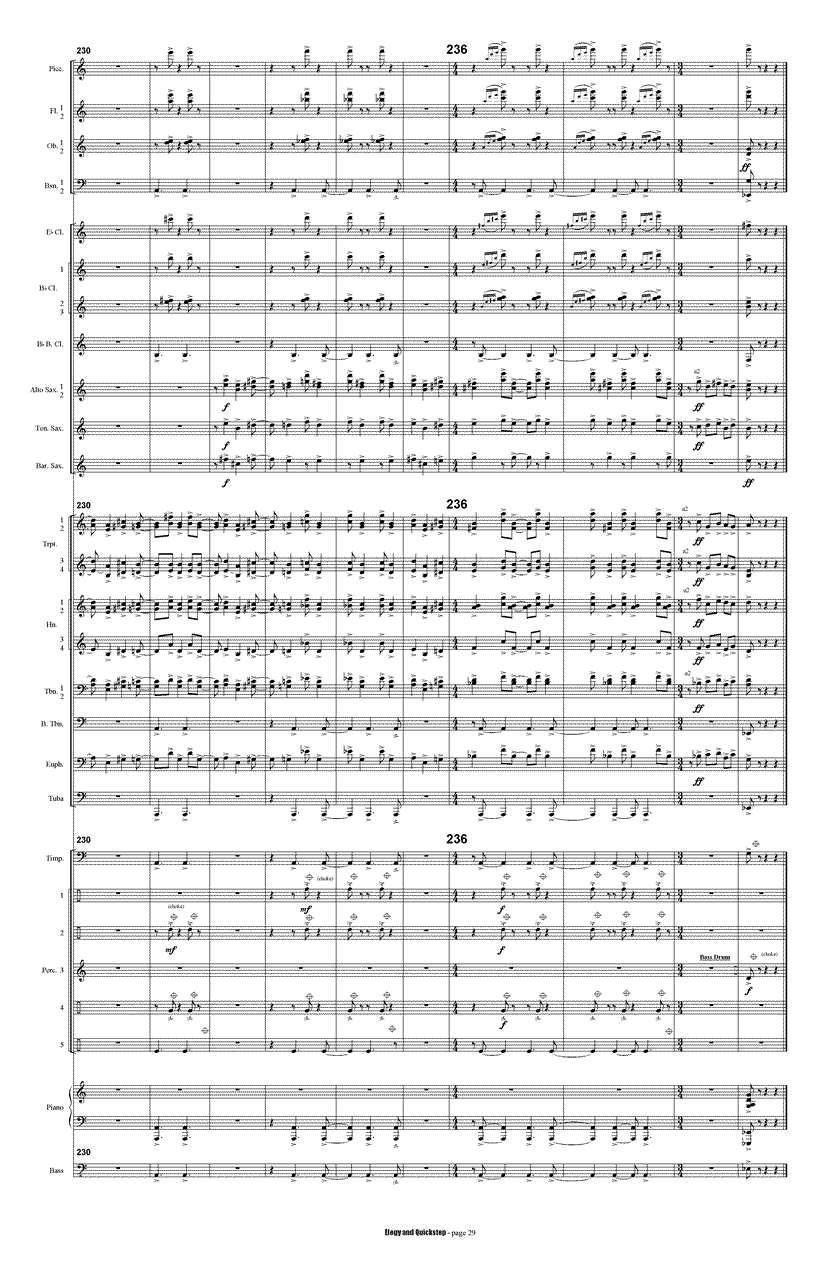Elegy & Quickstep
(2007) for wind ensemble
duration: 8 minutes
grade level: 5
premieres: St. Charles East (IL) High School, Jim Kull, Conductor
Perusal Score
Commissioned by a consortium led by St. Charles East (IL) High School, Jim Kull, Conductor
The other schools and conductors are:
Addison Trail (IL) High School, Mark Corey, conductor; Bloomington North (IN) High School, Janis Stockhouse, conductor; Lake Zurich (IL) High School, Josh Thompson, conductor; Nazareth Academy (IL), Eric Beltran, conductor; Plainfield Central (IL) High School, Dan Valkema, conductor; Plainfield South (IL) High School, Jerrod Cook, conductor; Sun Prairie (WI) High School, Steve Sveum, conductor; Waubonsie Valley (IL) High School, Matt Temple, conductor; Willowbrook (IL) High School, Bill Gilmer, conductor
Program Note
Composing these two movements in tempore belli (in time of war), I could not help but be influenced by the time in which we live, and this music indeed contains certain martial echoes. The first movement is an expressive lament, an elegy for the dead, with a variety of expression ranging from quiet tender moments to tense struggles and powerful exclamations. The second movement is a fast march, again colored by a variety of expressive tone, sometimes powerfully authoritative and determined, at other times searching, haunted, questioning. The concluding movement is built out of a persistent 6-note motive, foreshadowed in the Elegy, but brought to prominence in the Quickstep. It is most clearly heard over and over (and over) again in a three part canon about one minute into the movement and then again in the concluding brass refrain.
Wind Ensemble
Piccolo
Flute 1, 2
Oboe 1, 2
Bassoon 1, 2
Eb Clarinet
Bb Clarinet 1, 2, 3
Bb Bass Clarinet
Eb Alto Saxophone 1, 2
Bb Tenor Saxophone
Eb Baritone Saxophone
Bb Trumpet 1, 2, 3, 4
F Horn 1, 2, 3, 4
Trombone 1, 2
Bass Trombone
Euphonium
Tuba
Timpani (wind chimes)
5 Percussion
1: glockenspiel, xylophone, suspended cymbal (sm.)
2: vibraphone, suspended cymbal (med.)
3: marimba (4 octave), tubular chimes, bell tree, wind chimes, bass drum
4: 3 triangles (sm, med, lg), wind chimes, suspended cymbal (lg.), 2 woodblocks (sm, lg)
5: marimba, tam-tam, wind chimes
Piano (optional)
String Bass (optional)
ERRATA:
m.43, pc. 5, missing a half rest at end of bar
m. 140, piano (LH), pc. 3&5: F sharp and D sharp
m. 138-142, bassoon 1 should tie the last note of the bar to the next bar (in each bar here)
CHANGES:
50-51: flutes, oboes - one on a part.
152-155: delay cresc. in accompaniment so we hear trumpets, obs, asxs.
188: clar. 2&3, change to a quarter rest on beat two, making a more staggered entrance on the repeated concert B.
PERFORMANCE / REHEARSAL SUGGESTIONS:
I Elegy
Overall: there is a strand of melody from beginning to end, which should be made clear by connecting one phrase to the next, moving along (for ex.: don't let the eighth note meters slow down or be too slow), soloists in the middle section playing out confidently. Ideally, the students hear these connection and play off each others phrases. The melodic strand is centered on the top voice of the tutti passages, like in 17-31. Grace notes should all be played very fast (except perhaps the last ones at 62-63, which could be medium fast).
Details:
- Tempos should be quite fluid and expressive, with a great deal of rubato.
- Piano in bars 5-9 etc. should imitate wind chimes, with random bell-like repetitions of the given chord tones.
- If more than one player on a part in high woodwinds, gradually reduce as needed (have players drop out) to achieve decrescendos, like in bars 2, 4, etc. and have one on a part at places like m. 36.
-
Piano at m. 51-54 needs to mute the E strings with a L.H. fingertip, touching the string lightly near the end. The player may have to strike the keys mf to achieve a p sound. The fingertip touch should be light, producing a very resonant sound (pedal is down), not a completely muffled staccato.
1-10: sharp fp in wws, get very soft at end of dim, maybe drop to one on a part last beat or so
1-2 connect G flat to D flat in bsn, tsx, hns, euph, very expressive
5-10 very expressive in brass, make clear the articulations and cresc. (no let up before 8 or 11). fast grace notes.
12-13 same comments, but reversed for high ww and brass
21: horns should be clearly heard in foreground, momentarily taking over from trumpet (lead voice). sharp accents. lots of sound from piano w/muted string.
22-24: make sure tempo is 104 (at least) - not slower. very expressive, lots of dim at end.
28: sextuplet should be heard. It might be slower than the students are thinking.
30: comfortable mp...not too soft
31: VERY comfortable mf, full sound, long eighths so no breaks between the chords.
32-41: soloists should play out confidently. do not dim until written. (Ex. trombone in m.35, stay mf until after getting to the A flat in m.36) connect solo passages together so they sound like one line with new colors.
51: solo clar needs to be loudest on the F sharp. tendancy is to be too soft after the drop. delay dim in 53.
57-61: top voice (trumpets, Eb clar) needs to be heard above the others.
II Quickstep
Overall: Try not to let it get too heavy. Lots of people playing, but somehow, go for a light, fluid approach. short notes short. careful to keep accompanimental textures out of the way of the foreground.
Details:
113: those with the trill (G to A flat concert) - not fp, rather, sustained f then gradual dim.
129-151: eighths SOFT (accompaniment). foreground should be the sustained chords in cantabile phrases (130-136 saxes, 144-152 fls,
obs, saxes) - with lots of cresc. in those sustained parts. dealy dim until where written (after getting to the last note) - sustain, sing, project through these quartet phrases.
168, 174, 178: strong accents on Cs, clarifying the peak of the hairpins.
189-208: light f. don't get too heavy and loud.
208-210: intensify, leading to arrival at 211 (with strong trumpets!)
212-213; lots of dim., to p.
215-218: lots of cresc. to clear arrival at 219, setting up recap of fanfare.
225: wws need to tongue the first note of the bar.
226-end: nice full brass sound, keep the air moving for good souns and not just attack.
229-end: tam should be using a firm beater and not get too loud.






